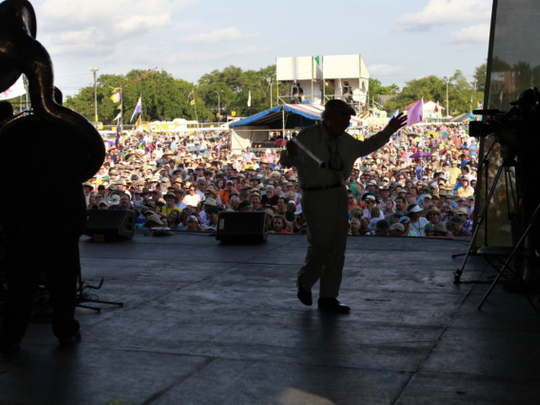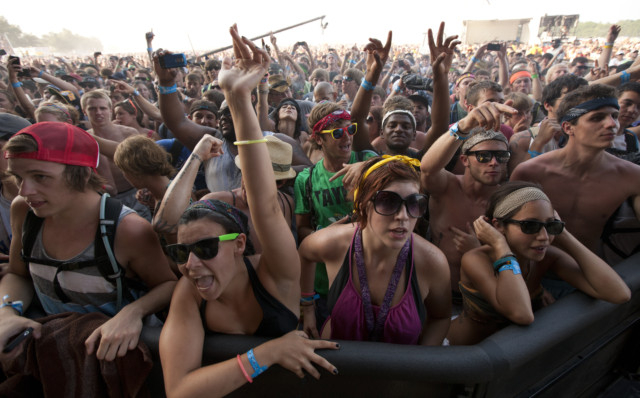
Karen Pery doesn’t consider herself a jazz fan. Yet for each of the past four years, she’s spent $3,000 (Dh11,010) and flown nearly 6,500 kilometres roundtrip to attend the New Orleans Jazz and Heritage Festival.
“It’s humid. It’s hot. It’s crowded,” the 42-year-old Los Angeles resident recalled. But, “It’s so much fun and it’s such a great experience”.
Music festivals are nothing new, but they are more popular than ever, attracting millions of fans. There are about 270 festivals of various types annually in the United States, and worldwide there are more than 800 in 57 countries, according to Pollstar, a trade publication covering the concert industry.
Yet, given that most bands tour, what would prompt someone to invest the time and money in travelling far afield to hear music they could hear closer to home?
For Pery, it’s a combination of the people — big headliners such as Bruce Springsteen and the E Street Band, Robert Plant and Simon and Garfunkel — exposure to new bands, great New Orleans food and a reason to spend some time in the city.
“It’s like homecoming. Everyone is super friendly. It’s this sense of, ‘We’re all in this together.’” said Pery, a life coach. “I have amazing stories from the Port-A-Potty lines.”
Last year, the music lineup was so impressive that she and her husband attended the first weekend in late April with their children, ages 8 and 10, then flew home for a few days before returning the following weekend to meet friends from Boston and Philadelphia.
“There is one direct flight from Los Angeles to New Orleans and it’s at 9.30am, and it’s a party on an aeroplane,” she said. “Everyone is going to the jazz festival.”
The New Orleans festival attracted 450,000 people over seven days last year, a lower daily attendance that some of the other major festivals. Since the city itself a tourist haven, it’s hard to say how many travelled specifically for the jazz festival, entering its 43rd year, versus how many were in town for another reason and decided to take in a day’s music.
But head a couple hundred kilometres east along the coast to the summer resort of Gulf Shores, and it’s much easier to see the draw that a music festival can have. That’s where the Hangout Music Fest — which debuted in 2010 amid the Deepwater Horizon oil spill — holds its annual event on the beach.
After the inauspicious start, the festival took off, selling out all 35,000 tickets each day for the three-day event and winning the 2011 Pollstar Music Festival of the Year award.
Between fans and the festival’s 5,000 workers, the population of Gulf Shores-Orange Beach nearly triples for the weekend before Memorial Day.
“We’ve had people travel from all 50 states for the festival — definitely opening up our typical eight-hour drive market,” said Missy Zak, spokeswoman for Meyer Vacation Rentals, which manages over 1,500 properties in the area.
Before the festival, occupancy in the rental units generally ran below 50 per cent for the third weekend in May. The past two years, it has been above 90 per cent for that period.
Despite the travel costs, some view music festivals as good value, and an incentive to visit places they otherwise wouldn’t.
“I think the big thing is you have tons of your favourite artists in one venue. It’s like a kid in a candy store,” said Megan Given, 25, a nail technician from Fort Collins, Colorado, who said aside from the festivals, she doesn’t travel much.
Last year, Given and ten friends in three cars drove for 24 hours to get to the Electric Forest Festival in Rothbury, a town of 430 about 400 kilometres west of Detroit.
The four-day festival in late June offered more than 50 bands for about $200. They camped to help cut costs, and because it is a “bonding” experience that they enjoy, she said.
“For us to see all the artists we really wanted to see individually by going to Red Rocks, (an amphitheatre near Denver,) it would have cost us so much more money,” she said.
Two years ago, Given drove 16 hours to the Wakarusa Music Festival in Ozark, held over four days in early June, because they wanted to hear String Cheese Incident perform. Next February, she and her boyfriend are flying to Costa Rica, where they plan to attend the Envision Festival. In addition to the five-day music, art and yoga festival, they are working with a travel agency to sightsee around the country for about 10 days.
Similarly, travellers from other countries come to attend festivals in the United States. Dan Berkowitz, head of CID Entertainment, a travel agent of sorts for music fans, said New York festivals tend to attract a lot of Europeans, while the California festivals attract fans from Australia and Japan.
“We have entire groups of 100 people at some of our festivals that are coming from Australia,” he said.
Berkowitz, who founded CID six years ago to provide logistics except for airfare, reminds fans to go with an open mind, and explore — by listening to new music or eating new food.
“Forget about your e-mail for a few days. Forget about your job. Forget about your lack of a job,” he said. “Have a good time and go.”
Pery has looked at other festivals, including June’s Bonnaroo Music and Arts Festival held on a 283-hectare farm 105 kilometres southeast of Nashville, and April’s Coachella Valley Music and Arts Annual Festival near Palm Desert, but she is hooked on New Orleans.
“I think what I love about the jazz fest is the variety of the music,” she said. “My husband has agreed that as long as we can we will go. We will be those old people camped out on the chairs.”



